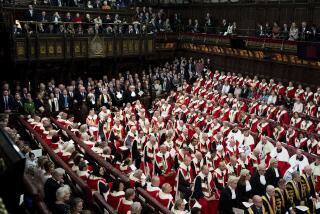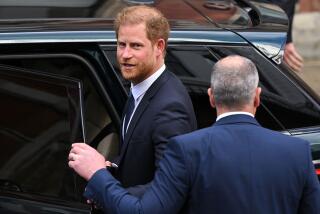New British Guide to Aristocracy : The Bluebloods: Debrett’s Has ‘Em All
- Share via
LONDON — Debrett’s guide to British bluebloods is 216 years old, 2,555 pages fat and weighs a hefty 5 pounds 3 ounces.
The new, 142nd edition of the aristocrats’ who’s who, “Debrett’s Peerage and Baronetage,” the first in five years, starts with Queen Elizabeth II and ends with an obscure baronet named Wood who died in 1974, the last of his line.
“To be complete we put in extinct titles as well, because sometimes a claimant comes along,” explained editor Charles Kidd in an interview.
Kidd said he mailed 25,000 questionnaires to collect facts for his stout handbook in familiar red-and-gold binding, irreverently called the Snobs’ Bible.
But anyone interested in the lordly side of British history has got to have it.
The publishers expect to sell 6,000 copies for the princely sum of 85 pounds, the equivalent of $106. If the rival publication, “Burke’s Peerage,” fails to bring out a new edition, which would be its first since 1970, sales will be higher.
‘Survived Everything’
“There is no other country with so structured and comprehensive a peerage, nor one that is so flourishing,” said Kidd. “The aristocracy has survived everything so far.”
The latest edition records the 1981 marriage of Prince Charles, the heir to the throne, to Lady Diana Spencer and the births of their sons, Princes William and Harry.
“For the first time since 1910, the reigning sovereign has a male heir with a male heir, a situation which has occurred with only seven other sovereigns,” the editor said.
“The mortality rate was much higher in the old days when heirs could expect to go out to battle and die there.”
Since the 1980 edition, 195 peers and 176 baronets in the hereditary aristocracy have died, but nearly all their titles have passed to descendants.
Lord Lucan, the peer who disappeared after the murder of his children’s nanny in 1974 and who is still wanted by Scotland Yard for the crime, is still listed in Debrett’s.
“Being accused of murder does not remove him from the peerage, and as nobody knows where he is, he is officially considered alive,” Kidd said.
If Britain still had capital punishment and Lucan were tried and sentenced to death, he would have been hanged with a silken rope--a privilege reserved for peers.
Despite the democratic trend of the 20th Century, plenty of bluebloods remain: Debrett’s records 30 dukes, 37 marquesses, 192 earls, 127 viscounts, 474 barons, 346 life barons and baronesses, and 18 peeresses in their own right--1,224 families in total.
One peerage succession is still being considered by the House of Lords committee of privileges -- because it is not convinced of its validity.
“It’s that of Viscount Doneraile, an air traffic controller who lives in Placentia, Calif.,” said Kidd, referring to Richard Allen St. Leger, 38.
“There is a question about his citizenship because his father lived and died in America and his mother was Irish.”
Can an American hold a British peerage?
The editor hesitated for a moment, and then answered: “I don’t think it would make any difference.”
Peers do not necessarily live in huge mansions surrounded by rolling acres of greenery. Family trees may branch in strange directions, and aristocracy is no guarantee against going broke.
Earl Nelson, a descendant of the great Admiral Horatio Nelson, is a detective sergeant in Hertfordshire. The Earl of Mount Charles is a caterer. Lord Teviot has changed careers, from bus driver to genealogist.
Kidd, whose job makes him one of the world’s experts on genealogy, said his favorite address in the big book is Two-Dot Ranch, the Canadian home in Nanton, Alberta, of the Earl of Egmont, a rancher.
An aristocrat usually has lots of names. Debrett’s will guide you to the one with the mostest, a member of the Dysart family who died in 1961.
He was Lyulph Ydwallo Odin Nestor Egbert Lyonel Toedmag Hugh Erchenwyne Saxon Esa Cromwell Orma Nevill Dysart Plantagenet Tollemache-Tollemache (pronounced Tolmash).
“A bit of a joke, I think, because his initials spell Lyonel the Second,” the editor said of the first fifteen segments of Plantagenet Tollemache-Tollemache’s name.
More to Read
Sign up for Essential California
The most important California stories and recommendations in your inbox every morning.
You may occasionally receive promotional content from the Los Angeles Times.













